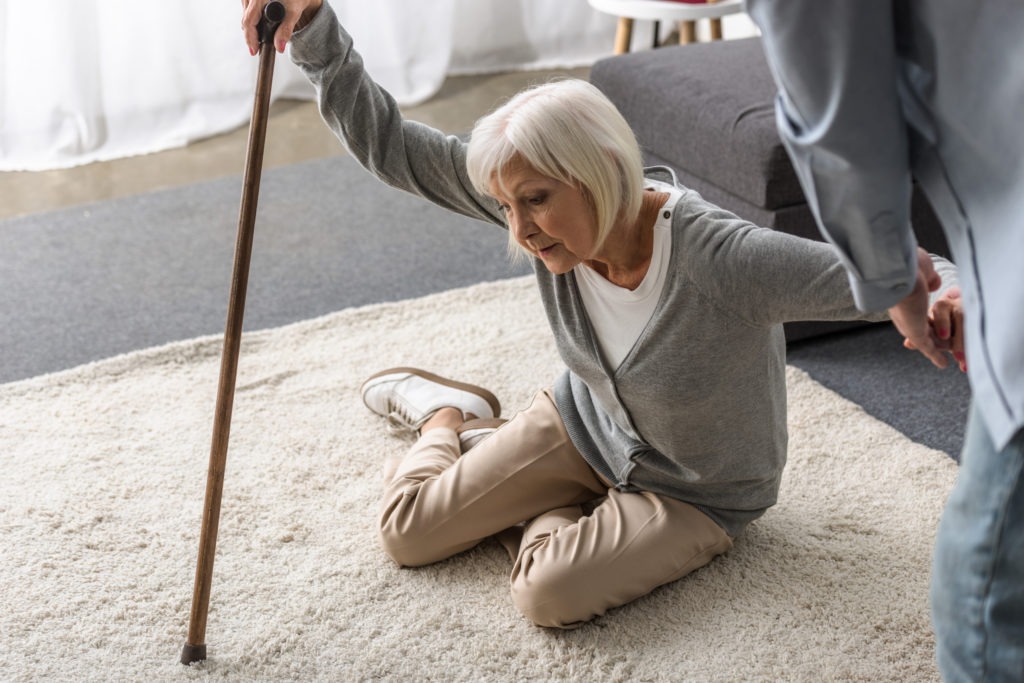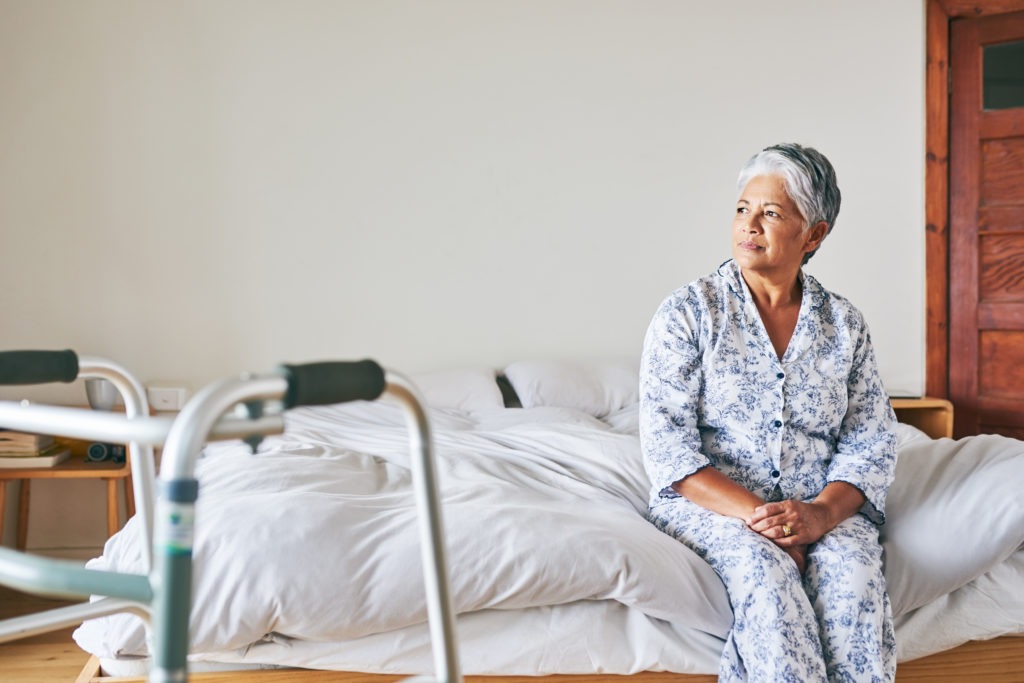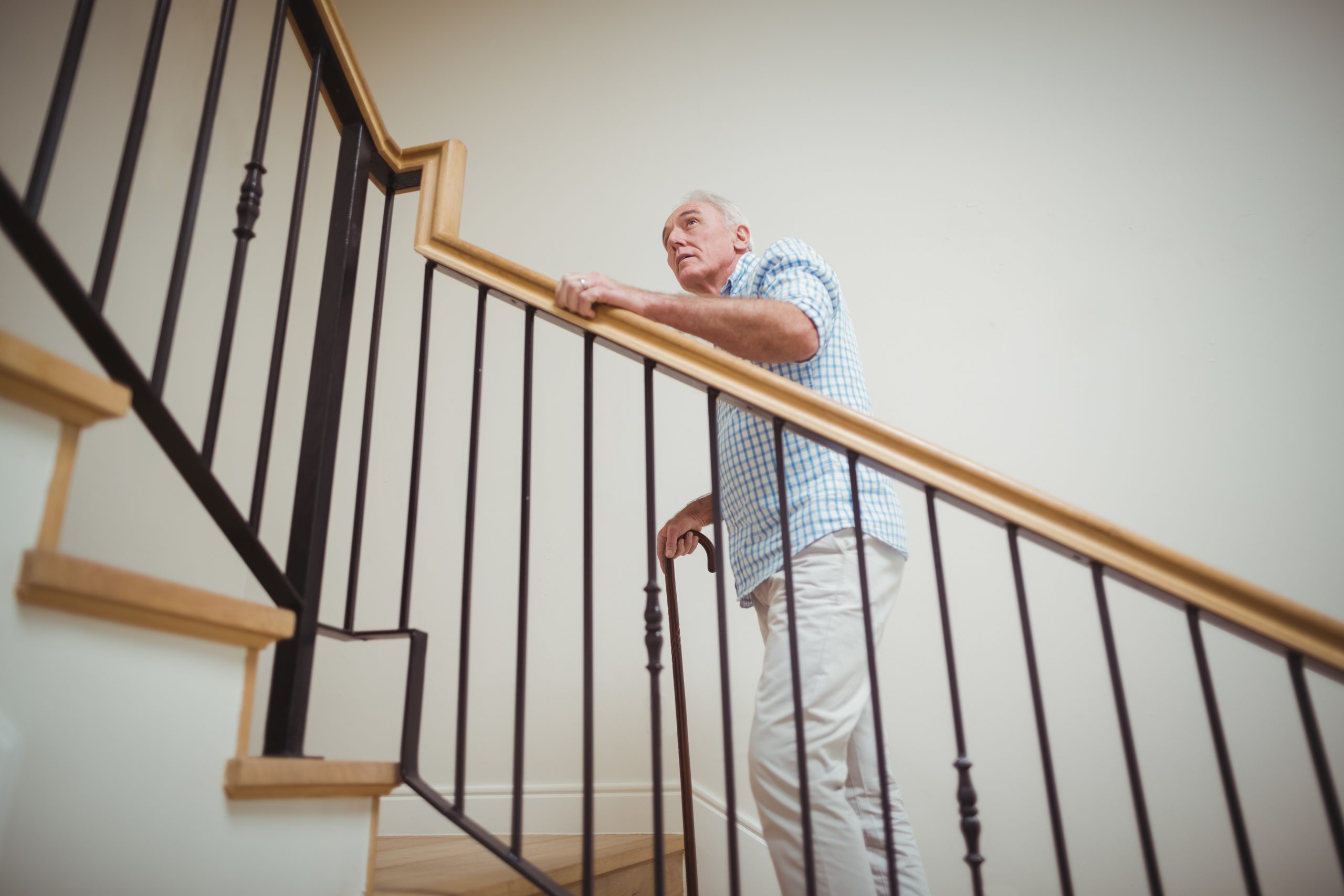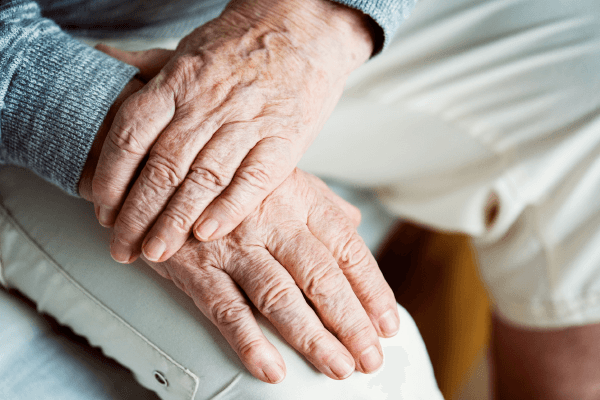Published: August 24, 2022
Reviewed by: Deidre Sommerer, LPN, MS, CMC, CDP.
If you have an older adult in your life who still lives at home, then you know how important that connection to a familiar place can be. A home holds memories that are cherished throughout retirement, and it’s a personal place that holds comfort. Yet sometimes, living at home is challenging for a senior, especially when disabilities are present. There are other senior living options, but making the move to a community may not be what your loved one desires.
In 2021, AARP did a survey on seniors and how they wanted to handle their retirement. The results found that 77% of adults over the age of 50 wanted to remain in their homes for as long as possible. This number has been consistent for over 10 years, and it shows that the majority of older adults want to age in place.
However, many home designs are for families, not older adults with mobility, vision or hearing concerns. As such, to make a home safe to live in during retirement, many seniors need to consider home modifications.
Home modifications for seniors focus on making the home safer and more accommodating to the changing physical needs of older adults. From widening doorways to accommodate walkers and wheelchairs, to adjusting bathrooms to reduce the risk of falls, there are many tasks seniors and their families can tackle to make a home a safe place to live .
This guide breaks down the different types of home modifications that can help, while also providing information about getting the right professional assistance to plan these changes.
Planning Your Home Modification Project
Before you start your home modification project, you need a plan. Several factors go into planning, and a solid strategy gives you the right foundation to do the job correctly and within budget. Below, we explain some of the first steps you can take to ensure you know which modifications are the best options for you or your loved one.
Consider Your Needs
Before you start a home remodeling project for seniors with disabilities, you must determine what needs remodeling to make your loved one safe and comfortable. In some ways, the answers to these questions are unique to each individual senior.
To begin, write down the disabilities and challenges your loved one faces. These might include:
- Impaired vision
- Mobility issues
- Weak grip or overall strength
- Difficulty with stairs or door jams
- Poor hearing
Once you have a list, consider areas of the home where those problems would raise issues. Start thinking about modifications, and then prioritize the ones that are most important. This priority list can help you plan for your modifications.
Hire an Expert
Before starting any serious changes, make sure you have the right experts in place. A Certified Aging-in-Place Specialist is an excellent resource to ensure your plans have exactly what is needed to make the home safe for your older loved one.
A Certified Aging-in-Place Specialist is a homebuilder specifically trained and certified in-home modifications for aging in place. CAPS professionals undergo training from the National Association of Home Builders to earn this designation. They can point you toward resources to assist with the financing of your aging-in-place home modifications, recommend the right products, help you understand building codes and standards, and give design recommendations. The NAHB has a searchable database you can use to find a builder with CAPS designation, or you can call (800) 368-5242 to find a local option.
Consult an Occupational Therapist
As you work on the design for your senior’s home, consider consulting with an occupational therapist, as the AARP recommends. OTs are health professionals who specialize in the needs of people with disabilities and how to accommodate those needs for home living tasks. An OT can help you understand your loved one’s unique needs and what accommodations will make the home accessible for them.
Medical Alert Systems for Seniors With Disabilities

While planning a remodel for a senior with a disability, consider adding medical alert systems to your plans. These systems provide wearable pendants or wrist bands that help track the senior’s activity within the home. They connect to devices that can call friends, family or a call center to get help if the senior falls or has another medical emergency.
Who Needs Medical Alert Systems?
Medical alert systems are great for people who live alone and are at risk of having a medical emergency or a fall. Many seniors, especially those with disabilities, fall into this category, but single adults living with chronic illnesses who aren’t seniors may also benefit.
The biggest concern for seniors living alone is the risk of falling. According to the CDC, 1 in 4 people aged 65 and older will fall each year, and 3 million older adults go to the ER for fall-related injuries every year. Over 800,000 people end up hospitalized because of injuries after a fall.
One of the risks of a fall is the possibility of not being able to get up again. If a senior who lives alone falls and is unable to get up, they could spend hours or even days on the floor, without food, water or medication, leaving them vulnerable to additional health issues. Without prompt care, some seniors will die as a result of their fall. Medical alert systems give seniors the tools they need to get help as quickly as possible, and some systems even alert caretakers to falls without the wearer doing anything to make that alert.
Benefits of Medical Alert Systems
Many caregivers can’t be with the seniors they care for 24/7. You may have a job or other family responsibilities that takes you away from your loved one for long periods of time. Medical alert systems provide several benefits in these scenarios, including:
- Ability to get help quickly in a medical emergency
- Peace of mind that the loved one is safe at home
- Tracking for seniors who are prone to wandering
- Instant connection to emergency professionals in a medical emergency
Types of Medical Alert Systems
There are several types of medical alert systems available to families who need these benefits. These include the following.
| Type of System | What It Does | Who It’s For |
| Monitored systems | Monitored medical alert systems are connected to a call center with trained professionals to help assess the senior’s situation and alert the appropriate help. | This system works best for seniors at high risk of serious medical concerns or falls because they ensure that someone will always answer the call when an emergency occurs. |
| Unmonitored systems | Unmonitored systems won’t alert a call center, but rather a pre-programmed friend or family member who can then get the appropriate help. | These work well for seniors who have caretakers living close to their homes and can answer when a problem arises. They also work well for budget-conscious families. |
| In-home systems | In-home systems have a wearable device connected to a home base station. The home base station also doubles as a speakerphone and will call for help when needed. | This system works best for seniors who spend most of their time at home. |
| Mobile alert systems | Mobile medical alert systems have GPS technology and communicate via cell phone towers, so a senior can use them outside of the home. | These systems work well for seniors who still maintain some of their mobility and freedom away from home. |
Where To Place Medical Alert Systems in the Home
If you’re adding a medical alert system while doing a home modification to a senior’s home, you need to consider which rooms are the best places for the device and its home base. Most systems have a range, so you need to put bases in enough rooms to have the whole house covered by the system. This often means putting one in the bathroom, bedroom and main living area to provide sufficient coverage. You can also think about which parts of the home are the most dangerous for a senior and add a medical alert monitoring system to those areas.
Financial Assistance for Medical Alert Systems
Several programs are available to help seniors and their caregivers cover the costs of a medical alert system. Consider the options below:
Medicare Part C
Medicare Part C, also known as Medicare Advantage, is an alternative to Medicare Part A and Medicare Part B, also known as Original Medicare. Original Medicare doesn’t offer coverage for medical alert systems, but Medicare Part C plans may, depending on the rules of the plan.
Who Is Eligible?
Medicare is available to seniors aged 65 and older who paid into the Medicare program or who are married to someone who did.
How To Apply
Apply for Medicare Part C through a qualified Medicare insurance provider, rather than through the government. You can find a list of plans online to browse. Remember that coverage options vary wildly.
Medicaid Waivers
Medicaid has several waiver programs that may cover medical alert systems. This can be an option if Medicare doesn’t reimburse for these systems. You need to check your state’s waiver program to see if this is an option, but some programs that do usually offer medical alert system coverage include the Money Follows the Person, Personal Care Attendant, and Home and Community-Based Services waiver programs.
Who Is Eligible?
Medicaid is an income-based program available to seniors who qualify based on their state’s income guidelines.
How To Apply
You can apply for Medicaid through your state’s online application process.
Department of Veterans Affairs TRICARE Program
The Department of Veterans Affairs often covers the cost of medical alert systems from one of its two preferred providers, LiveLife Personal Mobile Alarms and MedEquip Alert. This service is part of TRICARE, the VA’s insurance program for retired military professionals and their spouses.
Who Can Apply?
Seniors who are qualified veterans can apply for TRICARE.
How To Apply
Visit your local VA office to apply for any VA benefits, including medical coverage. You can also shop for a plan online.
Local Services Through the Area Agency on Aging
In addition to the federal programs mentioned above, you may be able to get help paying for monitoring systems through local or state programs. The best way to learn about these is to speak with the Area Agency on Aging in your region. They have trained counselors who can connect you with other agencies or services in your area for this type of help.
Additional Home Modifications To Consider
In addition to medical alert systems, you can make your home accessible and safer for aging in place with some of these modifications.
Make the Home’s Exterior Accessible
Depending on the needs of your senior, you should start with making the home’s exterior spaces accessible. An accessible interior is important, but if your senior loved one can’t get into the home safely or use the outdoor spaces with ease, the accessibility of the home will fall short. Here are some areas where you can make the exterior senior-friendly.
Walking Paths
If the home has sidewalks and walking paths, make sure these are level and wide enough for a walker, wheelchair or the use of a cane. For seniors in a wheelchair, paths should be at least 3 feet wide, and making them out of asphalt is ideal for creating a smooth, flat surface. Add exterior lighting to light these walking spaces so they are safe after dark. Security lighting is also helpful to add a measure of safety.
Landscaping
Many older adults enjoy gardening, so think about raised garden beds to make this accessible. If the senior isn’t going to spend time landscaping, consider landscape options that require minimal care, such as rock gardens or perennial plants that don’t require maintenance. Add sufficient lighting to prevent trip-and-fall hazards.
Doorways and Entries
Finally, consider the entry points to the home. If they include stairs, even just one step up from the garage into the home, you may want to add a ramp to make it accessible if your senior loved one is in a wheelchair or must use a walker. Make sure steps on a front porch have appropriate, sturdy handrails if you aren’t adding a ramp. Add non-slip surfaces to avoid falls. Widen doorways to accommodate wheelchairs.
If you’re adding a ramp, you may want to read about the specifications set forth by the Americans with Disabilities Act. While there isn’t a mandatory code for residential ramps except the width requirement of 36-48 inches, following the other guidelines will ensure your ramp is safe.
Disability-Friendly Flooring
Inside the home, start from the ground up. Flooring needs to limit the risk of a fall and, if the senior is in a wheelchair, needs to accommodate their mobility needs. This is important for all seniors, and in particular for those who have diabetic neuropathy, balance issues and poor eyesight. The floor should be even because they may not feel or see changes in the level of the floor or ledges that serve as door jams between rooms.
Choose the Right Material
When planning flooring, you will want to look for four main factors:
- Slip resistance
- Easy maintenance
- Durability to withstand wear and tear from a wheelchair or walker
- Ability to maneuver with disability assistance
Several options can work well as flooring, depending on your senior’s needs. Consider these:
- Laminate: Laminate wears better under wheelchairs than real wood, and it requires less maintenance. Look for a laminate with a textured surface for slip resistance. This type of flooring is prone to water damage, so it may not be the best choice for bathrooms and kitchens.
- Tile: Tile is wheelchair-friendly and, with a textured tile, slip-resistant. It’s easy to maintain and doesn’t get damaged by spills very easily. However, it’s very hard. If your loved one is prone to falls, however, tile could pose a safety risk. Consider tile in bathrooms and kitchens where spills may be common, but choose something softer for other areas of the home.
- Vinyl: Vinyl is a popular choice because it provides the durability of laminate with the water-resistance of tile. It can also be a very affordable option. It provides a flat, easy-to-navigate surface for wheelchairs.
- Carpet: Before you assume you cannot use carpet in a senior’s home, know that most wheelchairs can maneuver over carpet if it’s not too thick. Consider a commercial-grade, low-pile carpet for this need. A benefit of carpet is that it provides a softer surface if your loved one falls.
Other Flooring Considerations
While the material is the most important consideration when choosing disability-friendly flooring, it’s just one. You should also ensure there are few transitions between rooms, which can present a tripping hazard. Think about adding non-slip mats to slippery floors, like bathrooms, and avoid too many throw rugs, which can slip out from under a senior and present a fall risk.
Create an Accessible Bathroom
The bathroom is one of the most important rooms in the house, but it can also be one of the most hazardous. Falls are the leading cause of death in older adults, and a fall can often occur in the bathroom. Because of the small space and hard objects in a bathroom, falls are more than twice as likely to result in injury. Thus, the bathroom needs to be a primary focus as you make a home accessible for a senior loved one.
Accessible Bathing
The shower or bath is one place where seniors can often fall. Consider the following modifications to make it safer:
- Install a walk-in shower or tub with no lip to step over.
- Add seating in the shower or tub.
- Add grab bars in the shower.
- Use a handheld, flexible shower head.
- Install non-slip flooring in the shower or tub.
Accessible Toilet Considerations
Using the toilet independently is an important part of aging in place, but this can be a struggle for many seniors with mobility concerns or arthritis. To make it easier, think about replacing the toilet with one that has an elevated toilet seat so the senior doesn’t have to sit down or rise up to use the toilet. You can also install grab bars around the toilet, and make sure there’s ample space to transfer from a wheelchair to the toilet.
Additional Accessibility Features
In addition to the tub and toilet, you will want to consider adding:
- Lever handles on faucets that can easily be turned on and off
- Towel racks that double as grab bars
- Lowered sinks if your senior is in a wheelchair
- Additional lighting to make the space safe
Finally, consider widening the bathroom to accommodate wheelchairs and walkers. Your senior may need additional room to maneuver in the bathroom safely. You can often make it larger by taking out a nearby closet or extending the space into a bedroom.
Modifications in the Kitchen
Though the bathroom is the highest-risk area, the kitchen also poses several hazards for disabled adults. One of the main perks of aging in place is the ability to continue to cook, yet cooking involves hot surfaces, sharp knives and other risks. Also, spills can make the floor slippery and increase the risk of a fall. Traditionally designed kitchens may have counters that are too high for someone in a wheelchair or knobs that are difficult to turn for someone with arthritis or weakened muscles.
Modifications To Make Cooking Easier
First, focus on changes that can make it easier for an older adult to cook safely in the kitchen. Consider making these changes:
- Lower the counter for wheelchair users.
- Add touchscreen appliances with large, easy-to-read numbers.
- Install a shallow sink with lever handles.
- Install a faucet with lever handles instead of turn knobs.
Upgrade the Cabinets
Bending to reach things stored in low cabinets can be difficult with arthritis or mobility concerns. Consider adding cabinet drawers that pull out so the senior can see what’s inside without crouching. Often-used items can get hung on the wall rather than stored in the cabinet to keep them accessible. If the kitchen has a pantry, make sure the doorknob is easy to use. Think about adding under-the-cabinet lighting to improve visibility in the kitchen.
Accessibility in the Bedroom

Your senior loved one’s bedroom should be a tranquil, safe place to rest and even recuperate after illness or injury. You can introduce a few accommodations and changes here to make it safe. To make a bedroom accessible, consider these general ideas and thoughts:
- Expand the bedroom door so it’s a minimum of 32 inches wide.
- Make sure there’s a 3-foot pathway on either side of the bed and at the foot to make getting in and out easier.
- Lower the mattress so it’s no more than 22 inches from the floor. Add bed rails if necessary. Conversely, raising the bed for easier access is also an option for seniors who may not be able to squat down to less than 2 feet to get in and out of bed.
- Change the door handle so it’s easy to grasp and operate with just one hand.
Closet Upgrades for Seniors
In the closet, consider bifold or sliding doors for ease of use. Place clothing within reach, lowering the closet rod if needed. Avoid deep closet shelves, which your loved one may struggle to see or reach into. Install lighting so they can easily see their clothing choices.
Considerations for Multi-Floor Homes
As seniors get older, navigating stairs becomes more challenging. While a senior in a wheelchair cannot navigate stairs, even those who are still walking may find it challenging due to leg pain or neuropathy. A fall on the stairs can be dangerous, so you do need to address this.
While moving to a single-floor home would fix the problem, one of the reasons your loved one wants to age in place is to stay in their home as long as possible. Thankfully, you can make some modifications to make multi-story homes safer and more accessible.
Install a Stairlift
To make stairs safe, consider investing in a stairlift. This tool allows a senior to sit safely on a platform that carries them to the second story. It eliminates the need to climb stairs altogether.
Add a Home Elevator
If the senior uses a wheelchair, a home elevator is a better choice. This would allow the senior to roll into the elevator platform and lift to the second story without the need to transfer out of the wheelchair. Elevators increase independence while also adding safety.
Reinforce Handrails and Remove Slipping Hazards
If you don’t yet need a stairlift or home elevator, make sure the stairs are free from falling hazards. Start by reinforcing the handrails, ensuring that the stairs have handrails on both sides. Then, remove any carpet runners that could create a tripping risk, and make sure the flooring material on the stairs is not slippery.
Senior-Friendly Lighting and Electrical Modifications
As people age, their ability to see well starts to diminish. Many seniors develop cataracts or other eye problems that limit their vision. Making the lighting in the home safer will lessen risks for your loved one.
Light Dark Areas of the Home
Make sure the home is well-lit. If you have dark areas, add lighting to them. Some places you should consider adding lighting include:
- Stairways
- Hallways
- Bathrooms
- Under cabinets
- In closets
Look for lighting uniformity, as seniors struggle to adjust their vision for changing light conditions. Finally, make sure the lighting doesn’t create a lot of glare, which is hard on older eyes.
Light fixtures that spread light across walls and ceilings can reduce glare, create a more evenly distributed light, soften the lighting and make it easier on older eyes.
Upgrade Light Switches
Another change you can make to ensure areas stay well-lit is to upgrade light switches. Light switches with large levers or dimmer switches work well for seniors because they’re easy to find in the dark. Another option is to invest in motion-sensing lighting. These lights turn on when the senior enters the room or hallway, so there’s always proper lighting.
Federal Resources for Home Modifications
As you plan to make your home more senior-friendly, the cost is definitely a major consideration. Thankfully, you can find help for these costs, both on the federal and state level. These federal programs offer home remodeling help for people with disabilities to pay for some of their home modifications.
Fair Housing Act
Under the Fair Housing Act, landlords are prohibited from discriminating against applicants or residents due to the need to make reasonable accommodations for a disability. Though this Act doesn’t provide financial help to those who need to make home improvements, it does require landlords to make reasonable accommodations. This includes appropriate structural modifications to both the home and any common areas so that the disabled individual can enjoy it fully.
Who Is Eligible?
Anyone who has a physical or mental impairment that limits their ability to handle one or more life activities is considered protected under the FHA disability rules.
How To Apply
These protections are provided by law and don’t require an application.
FHA Section 203(k)
The FHA 203(k) program is a rehab mortgage insurance that lets a homebuyer purchase a home and finance the cost of its modifications and rehabilitation through one mortgage. For seniors who need accessibility, the program allows them to finance the rehab of their homes. These loans are more affordable than conventional loans for home modification in most instances.
Who Is Eligible?
Section 203(k) loans are available to homeowners who have at least $5,000 of work to do to their property and who have a property that fits the current FHA mortgage limit for their area. Accessibility modifications are covered under the program.
How To Apply
Seniors and their families apply for this home loan program through an FHA-approved lender in a similar way as a conventional loan application.
Specially Adapted Housing Grants
Seniors who are also disabled veterans may qualify for disability modification housing grants through the Specially Adapted Housing grant program. This program provides money for making the home more disability-friendly with changes like installing ramps or widening doorways for wheelchair use. Qualified veterans may receive up to $101,754 in 2022 for their home modification needs.
Who Is Eligible?
SAH grant money is available to veterans who own or will own their homes and have a qualified service-connected disability.
How To Apply
To apply for the SAH grant program, you fill out the Acquiring Specially Adapted Housing application (VA Form 26-4555) and provide your VA file or claim number and your Social Security number. You can apply directly on the eBenefits website or by mail. Seniors can also call (800) 827-1000 to get help.
Special Home Adaptation Grants
The Special Home Adaptation grant is also available to disabled veterans, but it opens the opportunity to veterans who don’t own the home. This program offers up to $20,387 in 2022 for home modification needs. The program is offered up to six times throughout the veteran’s lifetime, and the annual maximum changes each year.
Who Is Eligible?
The SHA grant program is available to disabled veterans who live with a family member who owns their permanent home. To qualify, you must have a service-connected disability.
How To Apply
The application process for SHA grants is the same as the SAH grant program. Fill out the VA Form 26-4555 and provide the veteran’s VA file or claim number and Social Security card. You can do this through the eBenefits website.
Medicaid Home and Community-Based Services Program
Medicaid is a federal program administered at the state level that helps low-income and disabled individuals with their medical needs. The Home and Community-Based Services waiver program allows states to provide money to disabled individuals, including seniors, to help them remain at home with community-based support. Many states have programs under this umbrella that offer home modifications.
Who Is Eligible?
Eligibility varies based on the state requirements, but typically these programs have disability requirements, age requirements and income limits. Most seniors and people with disabilities and low- to moderate-income qualify if their state has such a program.
How To Apply
If you’re interested in using Medicaid to help with home modifications, consider reaching out to your state’s Medicaid office or Area Agency on Aging to find out what programs are available near you.


